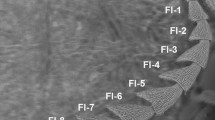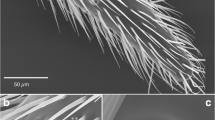Abstract
Chemoreception in spiders plays an important role in prey detection, conspecific recognition and recognizing chemical cues in the environment. Sexually dimorphic structures often suggest a role in mating and there are not many papers describing sexual dimorphism in chemosensory setae in spiders. In this study, we present the first detailed morphological description of scopulate putative chemosensory setae in the palpal tarsi (cymbium) and in the distal segments of the legs of adult males of seven species of the spider genus Ariadna (Segestriidae) [A. araucana Grismado, A. boliviana Simon, A. corticola Lawrence, A. maxima (Nicolet), Ariadna sp. 1 (AUS), Ariadna sp. 2 (AFR-CONT), Ariadna sp. 3 (AFR-MAD)]. Our results show three different grouping configurations of five morphologically different types of scopulate setae (types a–e). This is the first detailed description of this type of setae on legs of a Synspermiata spider contributing to the knowledge of the morphology of different types of sensilla in this group of spiders. Our findings show that the scopulated setae of Ariadna do not seem to be homologous to the pseudoscopula of Mesothelae and Mygalomorphae. We also discuss how our findings relate to previous hypotheses of female sex pheromone detection and support during copulation.















Similar content being viewed by others
References
Audouin V (1826) Explication sommaire des planches d’arachnides de l’Egypte et de la Syrie publiées par Jules-César Savigny, Membre de L’Institut; offrant un exposé des caractères naturels des genres, avec la distinction des espèces. Description de l’EgypteHistoire Naturelle 1(4):1–339
Barth FG (2000) How to catch the wind: spider hairs specialized for sensing the movement of air. Naturwissenschaften 87:51–58. https://doi.org/10.1007/s001140050
Barth FG (2002) A spider’s world: senses and behavior. Springer. Springer, Heidelberg, p 394. https://doi.org/10.1007/978-3-662-04899-3
Beatty JA (1970) The spider genus Ariadna in the Americas (Araneae, Dysderidae). Bull Mus Comp Zool 139:433–518
Bristowe WS, Locket GH (1926) The courtship of British Lycosid spiders and its probable significance. Proc Zool Soc Lond 22:317–347
De Spiegelaere W, Bosmans R (2009) Spider fauna in a grass dune remnant at the Black Sea coast (Romania), presenting seven new species for the Romanian fauna including the first description of the female Harpactea alexandrae Lazarov, 2006 (Dysderidae). Anal Știin ale Univ “Al. I. Cuza” Iași. Biologie animală LV:7–16
Foelix R (1970) Chemosensitive hairs in spiders. J Morphol 132:313–334. https://doi.org/10.1002/jmor.1051320306
Foelix R (1985) Mechano- and chemoreceptive sensilla. In: Barth FG (ed) Neurobiology of arachnids. Springer, Berlin, pp 118–137. https://doi.org/10.1007/978-3-642-70348-5_7
Foelix R, Chu-Wang IW (1973) The morphology of spider sensilla. II Chemoreceptors. Tissue Cell 5:461–478. https://doi.org/10.1016/S0040-8166(73)80038-2
Foelix R, Erb B, Michalik P (2010) Scopulate hairs in male Liphistius spiders: probable contact chemoreceptors. J Arachnol 38:599–603. https://doi.org/10.1636/B10-42.1
Foelix R, Rast B, Peattie AM (2012) Silk secretion from tarantula feet revisited: alleged spigots are probably chemoreceptors. J Exp Biol 215:1084–1089. https://doi.org/10.1242/jeb.066811
Ganske AS, Uhl G (2018) The sensory equipment of a spider—a morphological survey of different sensillum types in both sexes of Argiope bruennichi (Araneae, Araneidae). Arthropod Struct Dev 47:144–161
Gaskett AC (2007) Spider sex pheromones: emission, reception, structures, and functions. Biol Rev 82:22–48. https://doi.org/10.1111/j.1469-185X.2006.00002.x
Giroti AM, Brescovit AD (2017) Revision of the spider genus Gippsicola Hogg, 1900 (Araneae: Segestriidae). Zootaxa 4227(3):390–406. https://doi.org/10.11646/zootaxa.4227.3.6
Giroti AM, Brescovit AD (2018) The taxonomy of the American Ariadna Audouin (Araneae: Synspermiata: Segestriidae). Zootaxa 4400(1):1–114. https://doi.org/10.11646/zootaxa.4400.1.1
Grismado CJ (2008) A taxonomic revision of the spider genus Ariadna Audouin, 1826 in Argentina and Chile, with the description of five new species (Arachnida, Araneae, Segestriidae). Zoosystema 30:333–360
Harris DJ, Mill PJ (1977) Observations on the leg receptors of Ciniflo (Araneida, Dictynidae). II. Chemoreceptors. J Comp Physiol A 119:55–62. https://doi.org/10.1007/BF00655871
Haupt J (2003) The Mesothelae—a monograph on an exceptional group of spiders (Araneae: Mesothelae): morphology, behaviour, ecology, taxonomy, distribution and phylogeny). Zoologica 154:1–102
Heimer S, Hunter JM, Oey TS, Levi HW (1982) New sensory (?) organ on a spider tarsus. J Arachnol 10:278–279
Jocqué R, Baert L (2002) A revision of the Neotropical spider genera Tenedos O.P. Cambridge and Ishania Chamberlin (Araneae, Zodariidae). Bull Inst R Sci Nat Belg Entomol 72:67–173
Kaston BJ (1936) The senses involved in the courtship of some vagabond spiders. Entomol Am 16:97–167
Keyserling E (1877) Ueber amerikanische Spinnenarten der Unterordnung Citigradae. Verhandlungen der Kaiserlich-Königlichen. Zoologisch-Botanischen Gesellschaft in Wien 26:609–708
Koch CL (1843) Die Arachniden. Zehnter Band, Nürnberg, pp 37–142
Kronestedt T (1979) Study on chemosensitive hairs in wolf spiders (Araneae, Lycosidae) by scanning electron microscopy. Zool Scripta 8:279–285. https://doi.org/10.1111/j.1463-6409.1979.tb00639.x
Lawrence RF (1952) New spiders from Eastern Half of South Africa. Natal Mus Ann XII:183–226
Michalik P, Ramírez MJ (2014) Evolutionary morphology of the male reproductive system, spermatozoa and seminal fluid of spiders (Araneae, Arachnida)—current knowledge and future directions. Arthropod Struct Dev 43:291–322. https://doi.org/10.1016/j.asd.2014.05.005
Nicolet AC (1849) Aracnidos. In: Gay C (ed) Historia física y política de Chile segun documentos en esta republica durante doze años de residencia en ella y publicada bajo los auspicios del supremo gobierno. Zoología, vol 3, pp 319–543, pls 1–5. https://doi.org/10.5962/bhl.title.16172
Pérez-Miles F, Guadanucci JPL, Jurgilas JP, Becco R, Perafán C (2017) Morphology and evolution of scopula, pseudoscopula and claw tufts in Mygalomorphae (Araneae). Zoomorphology 136:435–459. https://doi.org/10.1007/s00435-017-0364-9
Perty M (1833) Arachnides Brasilienses. In: de Spix JB, Martius FP (eds) Delectus animalium articulatorum quae in itinere per Braziliam ann. 1817 et 1820 colligerunt. Monachii, pp 191–209, pls 38–39
Prandi L (1990) El género Ariadna (Araneae, Segestriidae) en la Republica Oriental del Uruguay. Arachnologia 5(Suppl):1–10
Prouvost O, Keller JM, Trabalon M (1999) Comportement sexuel et répartition des sensilles chez les mâles et femelles de Tegenaria atrica C. Koch (Agelenidae). Bull Acad Soc Lorraines Sci 38:6–14
Ramírez MJ (2014) The morphology and phylogeny of dionychan spiders (Araneae: Araneomorphae). Bull Am Mus Nat Hist 390:374 pp. https://doi.org/10.1206/821.1
Raven RJ (1985) The spider infraorder Mygalomorphae (Araneae): cladistics and systematics. Bull Am Mus Nat Hist 182:1–180
Ross K, Smith RL (1979) Aspects of the courtship behaviour of the Black Widow Spider, Latrodectus hesperus (Araneae: Theridiidae), with evidence for the existence of a contact sex pheromone. J Arachnol 7:69–77
Sánchez-Ruiz A, Brescovit AD, Alayón G (2015) Four new caponiids species (Araneae, Caponiidae) from the West Indies and redescription of Nops blandus (Bryant). Zootaxa 3972:43–64
Schiödte JC (1849) Om en afvigende Slægt af Spindlernes Orden. Naturh Tidsskr 2:617–624
Schulz S, Toft S (1993) Identification of a sex pheromone from a spider. Science 260:1635–1637. https://doi.org/10.1126/science.260.5114.1635
Schwendinger PJ (1990) On the spider genus Liphistius (Araneae: Mesothelae) in Thailand and Burma. Zoolog Scr 19:331–351. https://doi.org/10.1111/j.1463-6409.1990.tb00262.x
Simon E (1907) Etude sur les araignées de la sous-section des Haplogynes. Ann Soc ent Belg 51:246–264. https://doi.org/10.5962/bhl.part.1584
Tichy H, Gingl E, Ehn R, Papke M, Schulz S (2001) Female sex pheromone of a wandering spider (Cupiennius salei): identification and sensory reception. J Comp Physiol A 187:75–78
Tietjen WJ (1979) Tests for olfactory communication in four species of wolf spiders (Araneae, Lycosidae). J Arachnol 6:197–206
Trabalon M (2013) Chemical communication and contact cuticular compounds in spiders. In: Nentwig W (ed) Spider ecophysiology. Springer, Heidelberg, pp 125–140. https://doi.org/10.1007/978-3-642-33989-9_10
Vallet AM, Marion-Poll F, Trabalon M (1998) Preliminary electrophysiological study of the contact chemoreceptors in a spider. CR Acad Sci Paris 321:463–469. https://doi.org/10.1016/S0764-4469(98)80777-4
Wheeler WC, Coddington JA, Crowley LM, Dimitrov D, Goloboff PA, Griswold CE, Hormiga G, Prendini L, Ramírez MJ, Sierwald P, Almeida-Silva L, Alvarez-Padilla F, Arnedo MA, Silva LRB, Benjamin SP, Bond JE, Grismado CJ, Hasan E, Hedin M, Izquierdo MA, Labarque FM, Ledford J, Lopardo L, Maddison WP, Miller JA, Piacentini LN, Platnick NI, Polotow D, Silva-Dávila D, Scharff N, Szűts T, Ubick D, Vink CJ, Wood HM, Zhang J (2016) The spider tree of life: phylogeny of Araneae based on target-gene analyses from an extensive taxon sampling. Cladistics 0:1–43. https://doi.org/10.1111/cla.12182
World Spider Catalog (2019) World Spider Catalog. Version 20.0. Natural History Museum Bern. https://doi.org/10.24436/2. online at http://wsc.nmbe.ch. Accessed 4 Mar 2019
Acknowledgements
The authors thank the financial support provided by Fundação de Amparo à Pesquisa do Estado de São Paulo (FAPESP) to AMG (2013/20008-6) and ADB (2011/50689-0), and Conselho Nacional de Desenvolvimento Científico e Tecnológico (CNPq) to ADB (301776/2004-0). To the curators and museums for the loan of specimens studied. Also, to Dr. Rodrigo Hirata Willemart and two anonymous reviewers for their helpful comments on the manuscript. To Beatriz Maurício, from the Laboratório de Biologia Celular, Instituto Butantan, for helping with the SEM photos.
Funding
This study was funded by Fundação de Amparo à Pesquisa do Estado de São Paulo (FAPESP) (AMG-2013/20008-6; ADB-2011/50689-0) and Conselho Nacional de Desenvolvimento Científico e Tecnológico (CNPq) (ADB-301776/2004-0).
Author information
Authors and Affiliations
Corresponding author
Ethics declarations
Conflict of interest
André Marsola Giroti and Antonio Domingos Brescovit received research grants from Fundação de Amparo à Pesquisa do Estado de São Paulo (FAPESP). Antonio Domingos Brescovit received research grant from Conselho Nacional de Desenvolvimento Científico e Tecnológico (CNPq). The authors declare that they have no conflict of interest.
Ethical approval
This article does not contain any studies with live animals performed by any of the authors. The study was based only on dead specimens deposited in zoological collections.
Additional information
Publisher’s Note
Springer Nature remains neutral with regard to jurisdictional claims in published maps and institutional affiliations.
Rights and permissions
About this article
Cite this article
Giroti, A.M., Brescovit, A.D. Morphology of putative chemosensory setae in males of the spider genus Ariadna Audouin (Araneae, Synspermiata, Segestriidae). Zoomorphology 138, 249–263 (2019). https://doi.org/10.1007/s00435-019-00442-8
Received:
Revised:
Accepted:
Published:
Issue Date:
DOI: https://doi.org/10.1007/s00435-019-00442-8




